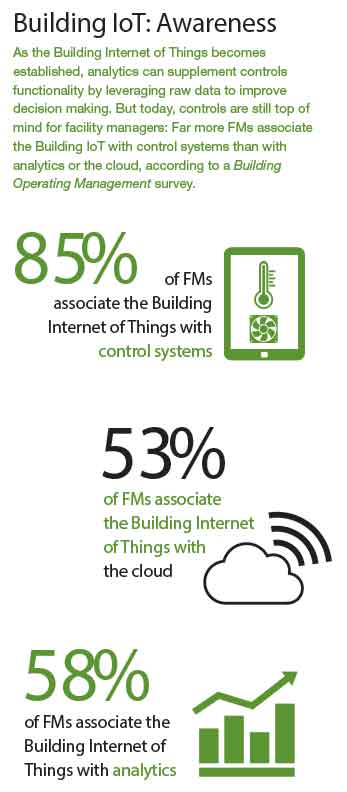How Big Data and the Building Management System Contribute to High-Performance Goals
Part 1 of a 3-part Green Building Report.
When Apple released the iPhone 2 in 2008, the App Store officially launched along with it. The platform’s introduction of third-party app development and distribution had a game-changing effect, similar to what building owners and managers might expect for building management systems (BMS) with the emergence of big data and the Building Internet of Things (IoT). And this disruption could not have come at a better time. Big data and the Building IoT have leveled the playing field. New players are shifting the way buildings are viewed, similar to how Tesla shifted people’s view on cars, or how the concept of apps transformed cellular phones to “smart” phones. In the building industry, the IoT has opened the door to integrate into millions of devices and systems. Combined with a growing desire to track and trend big data, and use it to achieve sustainability goals, the evolution of BMS is expanding beyond conventional mechanical and electrical building systems.
So what can facility managers do at this turning point within the industry in order to capitalize on the Building IoT and big data? How can they leverage a new way of thinking and operating their systems? Let’s take a step back and first consider the evolution of the BMS.
 Evolution of the BMS
Evolution of the BMS
The building automation industry has undergone significant changes since the first direct digital controls (DDC) systems. Much like new technologies that surged during this period, including the PC, video cassette recorder, and mobile phone, the BMS entered the marketplace and has evolved since.
Despite the capabilities, most BMS implementations underutilize the potential of an automation system to control and monitor a facility. For most, it only addresses the HVAC system; while for others, it includes scheduling and trending various systems such as lighting or access control. The bottom line is that the BMS can be leveraged to do much more.
The limitations are not due to a lack of effort, vision, or education in the marketplace, but rather the direct impact of how the industry views the lifecycle of a building. Traditionally, systems have been designed to incorporate more integration and energy efficiencies from the beginning. Unfortunately, the reality is that these forward-thinking designs are cut from a project’s scope due to cost restrictions and budgets that focus primarily on first cost during the construction phase, a process sometimes called “value engineering.”
Although the first cost may initially go down, the budget is negatively impacted as the overall lifecycle cost escalates significantly. More often than not, some of the original designs for integrations and energy efficiency upgrades get implemented after the construction project is complete, only with a significant premium.
One indication of the rising importance of energy efficiency is the growth of the LEED certification process. One purpose of LEED certification is to raise the bar in the pursuit of facilities to become more energy efficient. According to the U.S. Green Building Council, as of August 2015, LEED-certified buildings constituted more than 13.8 billion square feet of building space. Not only is this is a massive accomplishment, but a strong indicator of the direction in which buildings are moving in terms of efficiency. However, a new challenge exists, which is to ensure and verify that LEED certified facilities are still operating at LEED standards.
Related Topics:









 Evolution of the BMS
Evolution of the BMS




